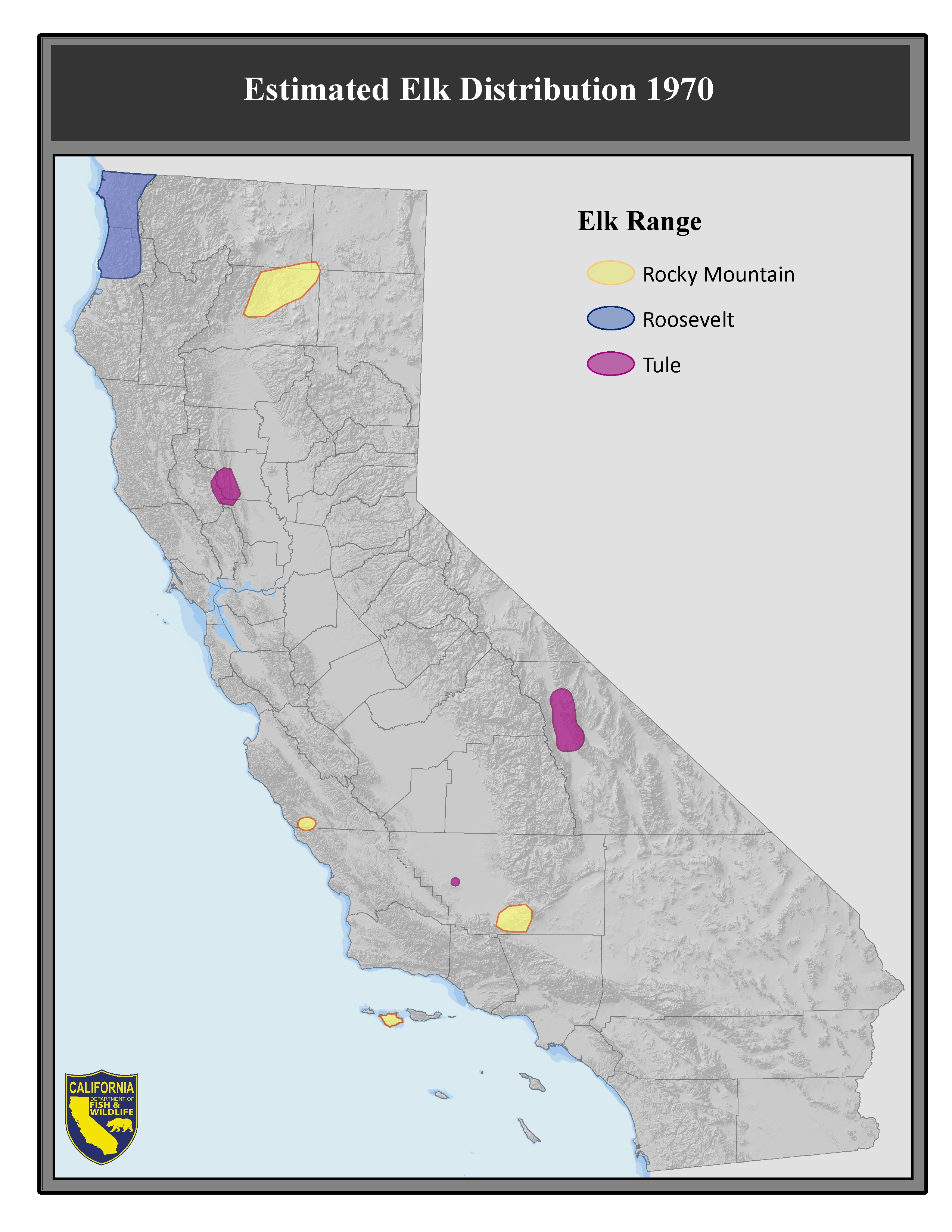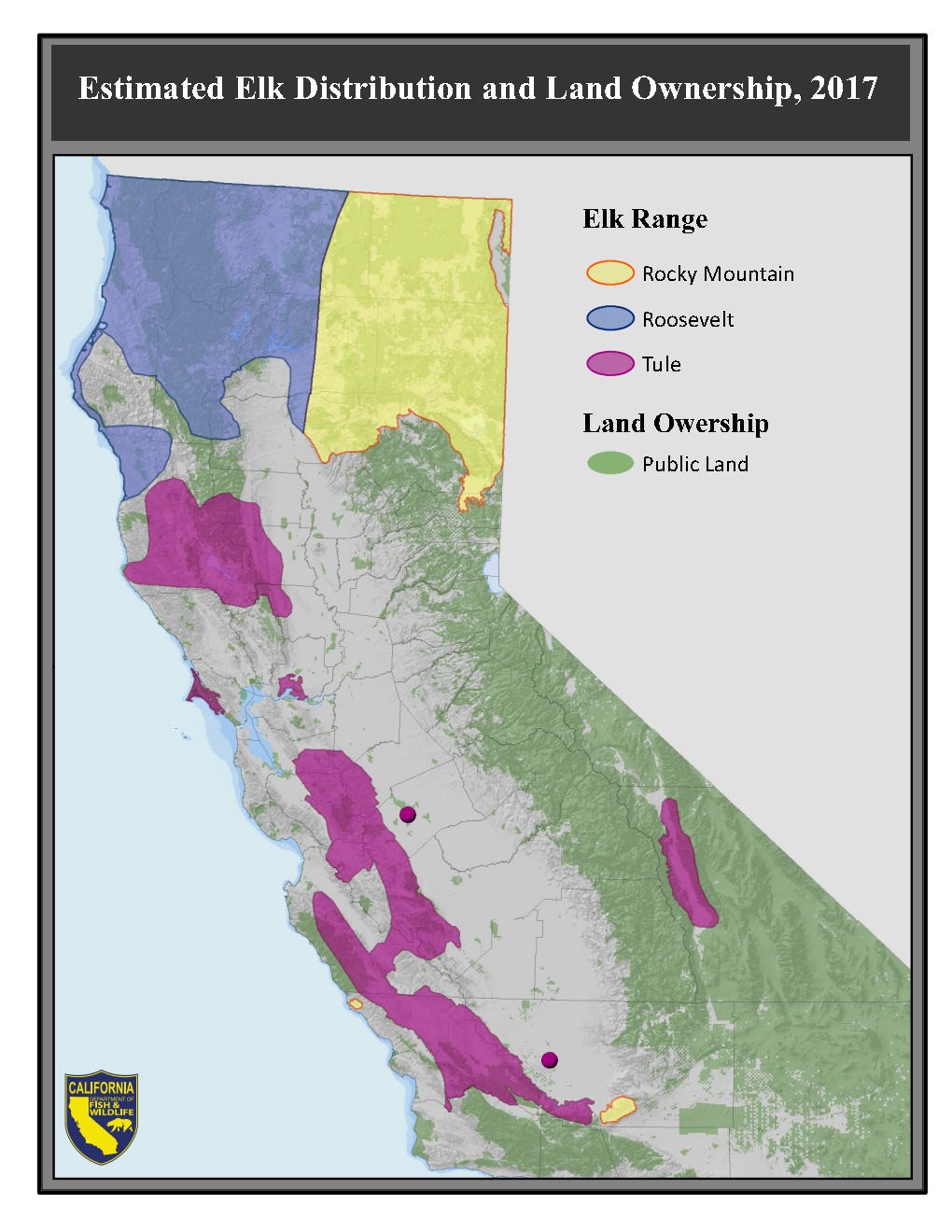Taxonomy and Nomenclature
- Class: Mammalia
- Order: Artiodactyla
- Family: Cervidae
- Scientific name: Cervus canadensis nannodes
- Common name: Tule elk
Description and Identification Aides
There are three species of elk that exist in California; Roosevelt (Cervus canadensis roosevelti), Rocky Mountain (Cervus canadensis nelsoni), and Tule (Cervus canadensis nannodes) elk. The Tule Elk are the smallest of all the elk species in North America and they are endemic to California. Given this, location and size are the easiest way to differentiate between the species. The adult bulls have an average weight of 450-700 lbs., with some topping the scales at over 800 lbs. The adult cows average 375-425 lbs. The yearlings (spike bulls) average about the same weight as the adult females (Hobbs 2007, McCullough, 1969). The coats are light, buffy beige with a darker brown long haired mane circling the necks of both the males and females. The calves are similar to deer fawns, with a light brown spotted coat. All animals display a prominent white rump. They average 7 feet in length and stand 4-5 feet in height at the shoulder. The male yearlings are also known as spikes, during their first year of antler growth they only have one antler that is very thin and spindly compared to the large racks that the dominant males demonstrate. The females do not have antlers and the males drop theirs annually which re-grow a little larger with more tines as they age (Kanewske, 2000).
Distribution and Range

 Tule elk are endemic to California and the most specialized elk in North America, given that they live in open country under semi-desert conditions, whereas the species as a whole typically occupies temperate climates and utilizes heavy cover at least seasonally (McCullough, 1969). In its historic range, the tule elk once occupied much of the central state. Their range spanned east of the foothills of the Sierra Nevada west to the coast line and north from the headwaters of the Sacramento River south to the Tehachapi Mountains. The variation in climate and topography illustrate the great adaptability of the tule elk (Phillips, 1976). Accounts in journals and diaries of early explorers indicate that approximately 500,000 tule elk inhabited the State. Between 1800 and 1840 hide and tallow hunters took large numbers of elk. From 1840 to 1849 southern Sacramento began to see a reduction in elk numbers due to increasing settlement and the gold rush. Market hunters then further reduced elk numbers and by 1870 only a few elk remained in the Buena Vista Lake area. DNA evidence indicates the tule elk numbers could have been as low as a single pair or a small number (2-4) of closely related individuals. In 1873 a law was passed to fully protect tule elk, although at that time it was unclear if any even remained. A rancher named Henry Miller realized the importance of this animal and diligently protected the last remaining tule elk (McCullough 1969).
Tule elk are endemic to California and the most specialized elk in North America, given that they live in open country under semi-desert conditions, whereas the species as a whole typically occupies temperate climates and utilizes heavy cover at least seasonally (McCullough, 1969). In its historic range, the tule elk once occupied much of the central state. Their range spanned east of the foothills of the Sierra Nevada west to the coast line and north from the headwaters of the Sacramento River south to the Tehachapi Mountains. The variation in climate and topography illustrate the great adaptability of the tule elk (Phillips, 1976). Accounts in journals and diaries of early explorers indicate that approximately 500,000 tule elk inhabited the State. Between 1800 and 1840 hide and tallow hunters took large numbers of elk. From 1840 to 1849 southern Sacramento began to see a reduction in elk numbers due to increasing settlement and the gold rush. Market hunters then further reduced elk numbers and by 1870 only a few elk remained in the Buena Vista Lake area. DNA evidence indicates the tule elk numbers could have been as low as a single pair or a small number (2-4) of closely related individuals. In 1873 a law was passed to fully protect tule elk, although at that time it was unclear if any even remained. A rancher named Henry Miller realized the importance of this animal and diligently protected the last remaining tule elk (McCullough 1969).
 By the turn of the century, the population of elk on the Miller-Lux Ranch had expanded and was causing extensive damage to fences, crops, and irrigated pasture. Miller requested the elk be relocated in an effort to reduce his damages. Over the next few years, the U.S. Biological Survey attempted to relocate tule elk via the "rodeo technique" (ropes and horseback). This technique was not very productive. In fact, the majority of the elk were killed during capture attempts or during transport to the release sites. Only one relocation attempt was considered partially successful when 21 elk were relocated to the Sequoia National Park. However, they died out by 1926. By 1914 tule elk were causing $5,000-$10,000 damage per year on the Miller-Lux Ranch (McCullough 1969). At this time, the California Academy of Science took over the tule elk relocation effort. The Academy was much more successful in capturing tule elk because they baited elk into a corral trap instead of attempting to capture them from horseback. During the period from 1914 to 1934, the Academy relocated 235 tule elk to 22 different locations, including Cache Creek and the Owens Valley. As was the case with the earlier relocation attempts by the U.S. Biological Survey, the majority of the relocation projects were unsuccessful. Tule elk at Cache Creek were allowed to expand their range and, until the summer of 1986, did not cause significant damage to private property. At the Tupman Tule Elk Reserve, elk were confined to a 953-acre enclosure, no mechanisms for population control were used, and the herd expanded to a point where the habitat was essentially destroyed and artificial feeding was necessary. This situation was greatly improved as a result of reducing the population by moving tule elk to other sites. In addition, the California Department of Parks and Recreation has undertaken numerous habitat improvement projects. In an effort to reduce damage to the improved habitat, the Department of Fish and Game has held the herd size at 30-35 individuals by periodically relocating surplus elk (California Department of Fish and Game, 1994). Currently there are approximately 5,700 tule elk throughout California in numerous herds.
By the turn of the century, the population of elk on the Miller-Lux Ranch had expanded and was causing extensive damage to fences, crops, and irrigated pasture. Miller requested the elk be relocated in an effort to reduce his damages. Over the next few years, the U.S. Biological Survey attempted to relocate tule elk via the "rodeo technique" (ropes and horseback). This technique was not very productive. In fact, the majority of the elk were killed during capture attempts or during transport to the release sites. Only one relocation attempt was considered partially successful when 21 elk were relocated to the Sequoia National Park. However, they died out by 1926. By 1914 tule elk were causing $5,000-$10,000 damage per year on the Miller-Lux Ranch (McCullough 1969). At this time, the California Academy of Science took over the tule elk relocation effort. The Academy was much more successful in capturing tule elk because they baited elk into a corral trap instead of attempting to capture them from horseback. During the period from 1914 to 1934, the Academy relocated 235 tule elk to 22 different locations, including Cache Creek and the Owens Valley. As was the case with the earlier relocation attempts by the U.S. Biological Survey, the majority of the relocation projects were unsuccessful. Tule elk at Cache Creek were allowed to expand their range and, until the summer of 1986, did not cause significant damage to private property. At the Tupman Tule Elk Reserve, elk were confined to a 953-acre enclosure, no mechanisms for population control were used, and the herd expanded to a point where the habitat was essentially destroyed and artificial feeding was necessary. This situation was greatly improved as a result of reducing the population by moving tule elk to other sites. In addition, the California Department of Parks and Recreation has undertaken numerous habitat improvement projects. In an effort to reduce damage to the improved habitat, the Department of Fish and Game has held the herd size at 30-35 individuals by periodically relocating surplus elk (California Department of Fish and Game, 1994). Currently there are approximately 5,700 tule elk throughout California in numerous herds.
Ecological Role
Like any other creature elk require food, water, and cover. McCullough (1969) found that annual forbs are extremely important in spring and early summer. Annual and perennial grasses are eaten by tule elk throughout the year. Sedges are also eaten (Thomas and Toweill, 1982).
Water must be available for drinking by tule elk; groups of tule elk are usually located within four miles of an open water source (Hobbs, 2007). Cover is important to tule elk, primarily for calving. In the La Panza herd elk are usually found out in the open even on the hottest days. While elk in the Cache Creek herd are observed lying down in the shade of oak trees on a regular basis (Hobbs, 2007).
Tule elk are large animals and hence require a good deal of space. But the amount of space required seems to be dependent on the quality of habitat they occupy. Elk on Grizzly Island occupy a relatively small area (less than 8,000 acres) for most of their activities even though they have tens of thousands of more acres available to them. Information gathered from the Department of Fish and Games hunting program indicate that elk on Grizzly Island are the heaviest and healthiest elk herd in the state. While movement patterns from Global Positioning Systems (GPS) collars on Cache Creek show much more extensive use of available areas. Elk at Cache Creek sometimes travel up to 15 miles or more throughout the year to obtain the resources they need (Hobbs, 2007).
Life History
Elk are highly social animals, and the herd is the focal point of its existence (McCullough, 1969). Tule elk utilize various portions of their range in response to seasonal variations in food availability (Thomas and Toweill, 1982). McCullough (1969) states that these seasonal movements are not considered migrations; they are local shifts in response to local conditions. The areas used during the summer are not inaccessible because of weather during the winter and the movements are not consistent from herd to herd. He also suggests factors that influence the various movements of the herds. First is the availability of high quality forage. A second factor is the land use by domestic livestock. This factor is dependent on the availability of suitable habitat to which the elk can shift. The third factor is human interference. When disturbed, herds will shift from place to place granted there is suitable forage available. In areas where there is little or no disturbance, the movements become fixed.
Elk are a herding species but the extent of herding can vary by sex and time of year. In the spring the animals can be scattered and the cows can be alone or in small groups while they give birth (Murie, 1951). As soon as the calves are able to walk without too much trouble the cows will usually group back up and travel as a herd with groups ranging from 15-200 (Hobbs, 2007). These groups will usually consist of cows, calves, and young bulls (spikes). Bulls are usually found in smaller groups and many times the larger more mature bulls will be by themselves until the breeding season begins (McCullough, 1969).
The breeding season or rut for tule elk occurs later in the season in much warmer temperatures compared to other elk (Wormer, 1969). The rut usually occurs from August through October. The peak of the rut on Grizzly Island is usually late August to Mid September (Hobbs, 2007). Bugling is the most characteristic act of the bulls rutting behavior. Bugling is a call the bulls make to attract mates. As the rutting season progresses bulls begin to compete for cow herds.
The gestation period is 255 days with most young being born in May and June, but calves have been reported as early as February and March in some areas. Calving usually occurs away from the group in areas with cover such as tall grass or brushy areas and away from disturbance (Zeiner, Laudenslayer, Mayer, and White, 1990). Cows will become sexually mature around the age of two and the calves will usually remain with their mothers to become part of the cow herd (Hobbs, 2007).
Threats and Vulnerabilities
McCullough (1969) showed that competition with domestic stock proved to be a minor threat to elk. However, overgrazing or high intensity grazing can leave large areas with no food value for the elk for extended periods of time. Conflicts between ranchers and elk have posed a problem. Elk are an increasingly popular game animal, and management efforts in the last few decades have caused the population to grow. As the numbers increase so does the incidence and intensity of damage to agriculture (deCalesta and Witmer, 1994). Tule elk are an example of genetic bottlenecking. This can lead to minimal variation and can cause the species to become vulnerable to diseases. Modeling of the genetic characteristics of tule elk have indicated that management strategies involving transplants among all tule elk herds appear to be the most beneficial for the maintenance of nuclear variation in this species (Williams, Lundrigan and Rhodes, 2004). Continued human development and encroachment is a threat to tule elk. A large portion of their range is on private property with no permanent protection. In addition, many of the subherds are in close proximity to high value coastal and bay/mountain areas. There is a constant threat of development or subdividing the properties into small ranches. One of the other major threats is habitat degradation and invasive of noxious weeds. Exotic weed species (star thistle) is a large problem for the Cache Creek herd, as it has taken over many acres of otherwise suitable habitat (Hobbs, 2007)
Recovery and Protection Needs
In limited space, a growing elk herd can out grow its environment which leads to overpopulation, habitat destruction, stress, starvation and disease. To prevent these problems or to decrease the occurrence of them, relocation efforts should be maintained (California Department of Fish and Game, 1990). Since they are now protected and managed, continuing to improve and/or sustain suitable habitat as well as possible efforts for new locations should be made. There are only a handful of books and articles written specifically on tule elk. Further current research should also be done to better understand this unique species.
Citations
- California Department of Fish and Game. 1994. Environmental Document: Tule Elk Hunting. Department of Fish and Game Sacramento office, 1812 9th Street, Sacrmento, CA 95811.
- California Department of Fish and Game. 1990. California's Tule Elk. Video cassette.
- deCalesta, D.S. and G.W. Witmer. 1994. Prevention and Control of Wildlife Damage.
- Hobbs, J. 2007. Personal Communication. 23 April, 2007.
- IUCN 2006. 2006 IUCN Red List of Threatened Species. www.iucnredlist.org. Downloaded on 15 April 2007.
- Kanewske, R. 2000. www.sfsu.edu. Downloaded 15 April 2007.
- McCullough, D.R. 1969. The tule elk, its history, behavior, and ecology. University of California Press.
- Murie O.J., 1951. The Elk of North America. The Stackpole Company, Harrisburg, Pennsylvania and the Wildlife Management Institute, Washington D.C. 376 pp.
- Phillips, W.E. 1976. The Conservation of the California Tule Elk. The University of Alberta Press. 120 pp.
- Thomas, J.W., and D.E. Toweill, eds. 1982. Elk of North America: ecology and management. Stockpole Books, Harrisburg, Pennsylvania. 698 pp.
- Williams, C.L., B. Lundrigan and O.E. Rhodes, Jr. 2004. Journal of Wildlife Management. 68: 109-119.
- Van Wormer, J. 1969. The world of the American Elk. J.B. Lippincott Company, Philadelphia and New York. pp.
- Zeiner, D.C., Laudenslayer, W.F., Mayer, K.E. & White, M. 1990. California's Wildlife. Volume III: Mammals. Sacramento, California: California Statewide Wildlife Habitat Relationships System, Department of Fish and Game.